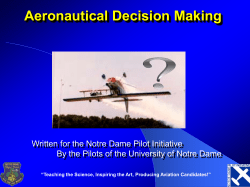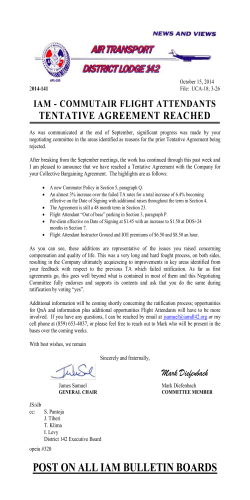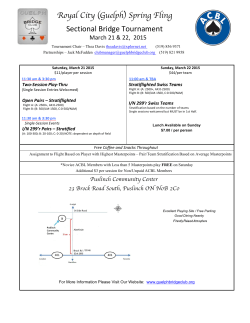
Speakers` biographies - EASA
Flight & Human Factors Conference Cologne, 8-10 June 2015 …XYZ Cologne, …DAY …January 2012 7th EASA Rotorcraft Symposium Cologne, 4th-5th December 2013 Speakers’ biographies (in order of presentations) OPENING REMARKS François FABRE, EASA Chief Expert - Flight François FABRE, EASA Chief Expert – Flight - Aeronautical Engineer, graduate from the French Air Force Academy in 1975. Militarypilot till 1989. Graduate from the US Air Force Test Pilot School in 1984. French Air Force Test Pilot, then Instructor for Test Pilot and Examiner for Test Pilot Carrier of Certification Test pilot for the French Civilian Aviation Authority (F-DGAC) and the Joint Aviation Authorities (JAA) started in 1991. European Certification Test Pilot for Airbus, Dassault, Boeing products including the A380, the B787 and recently the A350. Working at EASA since 2008. In parallel carrier of airline pilot with a major European company on B767 and B777. Type Rating Instructor (TRI) and Type Rating Examiner (TRE) for the F-DGAC. More than 10 000 flight hours including 4000 as Test Pilot Member of the FAA Human Factors Team having issued the report “The Interfaces Between Flight crews and Modern Flight Deck Systems” in June 1996.Hold a University Degree in “Human Factors for Design of Human Machine systems in aviation”. Current position at EASA: “Chief Expert Flight and Human Factors”. 1) HEAD-MOUNTED DISPLAYS Vincenzo PENNETTA, EASA Flight Test Engineer – Fixed Wings Vincenzo PENNETTA – started his career in aviation in 1983 as a Cadet in the Italian Air Force Academy (Pozzuoli, Naples). After graduation from Academy and from the University of Naples in Aeronautical Engineering in 1989 (110/110 Cum Laude), he was appointed 1st Lieutenant and assigned to the Italian Flight Test Center (Reparto Sperimentale Volo) in Pratica di Mare Air Force Base, 15 km south of Rome. He graduated in 1991 (class 90B) as Flight Test Engineer -Fixed Wing - from the USAF Test Pilot School in Edwards AFB (USA California). Since then he was involved as Lead Project Flight Test Engineer in several test trials for fighter aircraft (Tornado, Eurofighter, AM-X) and air-to-air refuelling trials with B-707 T/T, C-135FR, VC-10. He holds the Italian Air Force Certificate for FTE n.49. From 2002 he left active duty with the rank of Major to join the Italian Accident Investigation Board (ANSV, an agency under the control of the Italian government - -), where he was involved in many aircraft accident investigations (Linate runway collision accident in 2001, Investigator in Charge of the ATR 72 Tuninter ditching off-shore Palermo, etc.). In 2005 he was appointed as the Head of investigation Department. In May 2009 he joined the European Aviation Safety Agency in Cologne (Germany) as Safety Investigation Officer within the Safety Analysis and Research Department. Acted as a focal point in the Agency for investigation related activities in order to have a centralized coordination function. In January 2014, following an EASA external selection procedure, he has been appointed as Flight Test Engineer – Fixed Wing in the Certification Directorate. Works in several projects (DA Falcons, ATR, Cessna 680A, Sukhoi Superjet and others). 2) B777 – FOLDING WING TIP Massimo BAROCCO, EASA Flight Test Pilot – Fixed Wings Massimo BAROCCO - After having graduated in Aeronautics from the Air Force Academy 1984, Massimo Barocco attended the “Euro NATO Joined Jet Pilot Training” at Sheppard AFB where, in 1985, he graduated as fighter pilot. Then, after 4 years of operational experience as a fighter bomber pilot on Tornados, he was sent to the Empire Test Pilot School at Boscombe Down (UK) where, in December 1991, after having successfully completed the course, he was nominated “test pilot”. Afterwards, he was assigned to the Air Force Flight Test Centre of Pratica di Mare where he spent all his military test pilot career and in 1996, he was also appointed Commanding Officer of the Italian Official Test Squadron. www.easa.europa.eu Page 1 of 3 Flight & Human Factors Conference Cologne, 8-10 June 2015 After having completed his commanding post, he resigned from the Air Force and joined Alitalia where he was nominated technical pilot of the MD 80 fleet and he was tasked to form a test team in charge of all maintenance test flights and STC for the Airline. In 2009, he left Alitalia to become Chief Test Pilot of OMAS SUD Sky Technology where he was responsible to conduct all the necessary development and certification flights of a new General Aviation twin engine aircraft and a new all composite single engine trainer. In 2012, Cpt. Barocco joined the Agency as a fixed wing test pilot and he is responsible to conduct certification activities on many aircraft, including Airbus, Boeing and Agusta products. Up to now Cpt. Barocco has logged over 10000 flight hours, including over 2000 hours of flight test activity, on over 50 aircraft types, including military jets, general aviation aircraft, business aircraft and transport aircraft. 3) DEBRIEF OF A350 CERTIFICATION CAMPAIGN Laurent BUSSIÈRE, EASA Flight Test Engineer – Fixed Wings and Massimo BAROCCO, EASA Flight Test Pilot – Fixed Wings Laurent BUSSIÈRE - is an “in house” lead flight test engineer. After an operational career in the French Air Force, Laurent joined flight test in 2006 in order to prepare the flight test and the operational evaluation of the A400M. He was also involved in many project to upgrade French military transport aircraft capabilities during this time. He joined EASA in 2013 and was involved on A350 flight test campaign. He is graduate from French Air Force Academy and EPNER flight test school. 4) DISCUSSION SESSION: MEANS OF COMPLIANCE FOR SINGLE FAILURES Simon SEYMOUR-DALE, EASA Flight Test Pilot – Fixed Wings and John MATTHEWS, EASA Flight Test Engineer – Fixed Wings Simon SEYMOUR-DALE – Simon Seymour-Dale joined the Royal Air Force in 1988 and graduated as a test pilot at EPNER in 2000. He has spent 14 years in military large aircraft test, with a tour at ETPS as a test pilot instructor and a final tour as the commanding officer of the heavy aircraft test squadron. He has over 5000h flying time on over 60 aircraft types. His time at EASA can be measured on a watch rather than a calendar and he is learning his new trade as a certification pilot on the A320neo project. John MATTHEWS - BSc Honours Aeronautical Engineering 1979 British Aerospace Flight Test 1979-1984 Tornado ADV CAA Flight Test 1984-2007 EASA Flight Test 2007Beech 300 & 1900, Harbin Y12, Do 228-200 & 212, BAe Jetstream 32 & 41, MD 11, MD 80, B717, Gulfstream IV, V & VI, A330, A340, A380, A350, B 757, B747-8, B787 Member Flight Test Harmonisation Group 5) NEW ICING REGULATIONS Matthias SCHMIDT, EASA Flight Test Engineer – Fixed Wings Matthias SCHMIDT is a Flight Test Engineer for Fixed Wing Aeroplanes. After graduating from the Technical University of Braunschweig with a Master Degree in Mechanical Engineering, Aeronautical Engineering in 1988 he started his professional career as a Scientific Employee of the German Aerospace Research Establishment (DLR) in Braunschweig, Germany. In an industry cooperation he designed analysed and tested airfoils for a European tiltrotor aircraft project. In 1992 he joined the German National Aviation Authority (Luftfahrt-Bundesamt) in Braunschweig, Germany. He was assigned responsibility in aeroplane type certification as an expert for Performance and Flight Manuals. The scope of work was expanded to flight test after his Flight Test Engineer education at International Test Pilot’s School, Coventry, UK, in 2000. Following reorganization in light of European Aviation Law he took also responsibility as Project Certification Manager for Small Aeroplanes. In 2013, he joined EASA’s Certification Department, Cologne as Flight Test Engineer for Fixed Wing Aeroplanes. As a flight test engineer, his main projects were Airbus A310 MRTT (Multi-Role Transport Tanker), Dornier 328, Dassault Falcon 7X, Airbus A400M and A350 projects. His current TC projects are Dassault Falcon 5X, Gulfstream GVII, Embraer E2 Jets. www.easa.europa.eu Page 2 of 3 Flight & Human Factors Conference Cologne, 8-10 June 2015 6) PILOT ERROR ANALYSIS Alfred Roelen and Rombout Wever, Department of Safety and Flight Operations, National Aerospace Laboratory NLR Alfred Roelen – is a senior researcher at NLR’s Air Transport Safety Institute in Amsterdam and a lecturer/researcher at the Aviation Academy of the Amsterdam University of Applied Science on the subjects of Human Factors and Safety Management. With more than 20 years of experience in aviation safety research and consultancy, Alfred Roelen is one of the Netherlands’ leading experts on safety performance and safety management in which he is a consultant to both industry and governments. His current research topics include safety performance and safety management, safety modelling, continued airworthiness and flight crew fatigue. Alfred also is an internal auditor of the research aircraft maintenance group. This is a Part-145 and Part-M certified organisation within NLR that is responsible for continued airworthiness of the NLR research aircraft. Rombout Wever – Senior safety consultant. Mr Wever is working in aviation safety research and consultancy projects for various civil and military aviation stakeholders such as authorities and operators. Initially his area of work also included flight testing, but nowadays the majority of projects include safety assessments of operational procedures and new technology, safety management systems consultancy, the development of safety risk models, and flight data monitoring. He is also an aircraft accident investigator at NLR and was involved in civil and military accident and incident investigations. He has received a Master degree in Aerospace Engineering of Delft University of Technology. 7) AUTOMATIC TAKEOFF THRUST CONTROL SYSTEM (ATTCS)AND MAXIMUM CONTINUOUS THRUST (MCT) ISSUES Matthias SCHMIDT, EASA Flight Test Engineer – Fixed Wings 8) TEST REGULATIONS UPDATE Simon SEYMOUR-DALE, EASA Flight Test Pilot – Fixed Wings www.easa.europa.eu Page 3 of 3
© Copyright 2025









